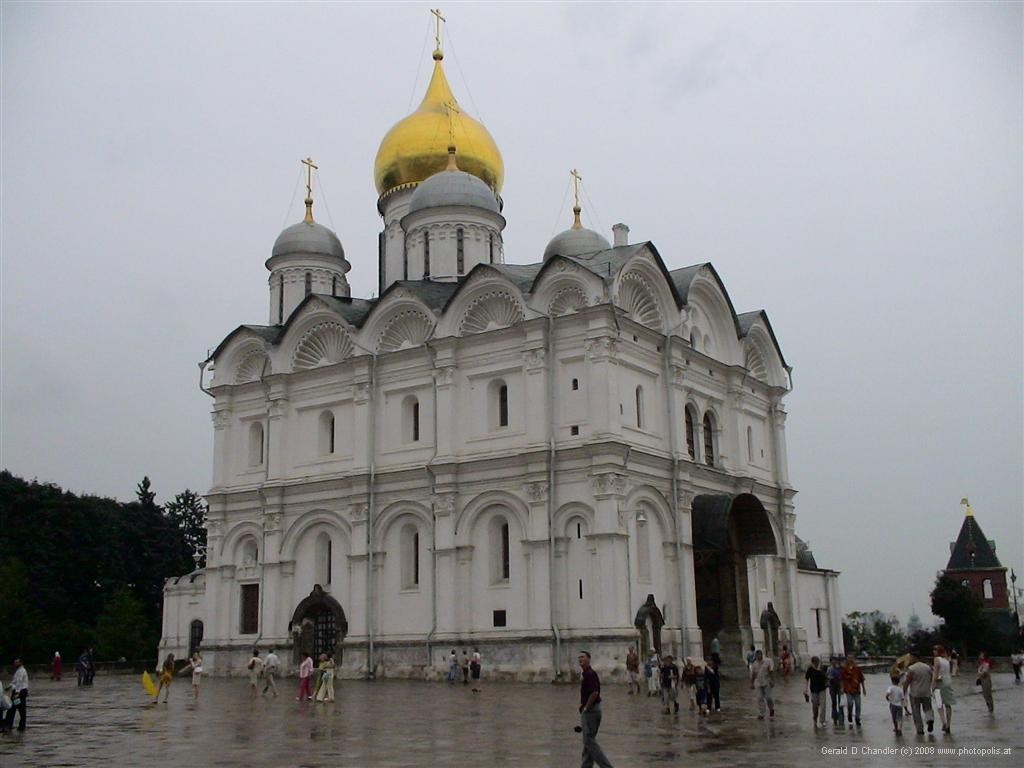Home | Front Page | Index | Blog | New | Contact | Site Map
Arrival
Registering
First Steps
Kremlin
Dom Museums
Grand Museums
Statues
Churches
Monasteries
Metro
Markets
Radonezh Dacha
Maps
Foto Show
Other Russia
Russia
Golden Ring
St Petersburg

Travel 2005
Berlin
Paris
Moscow
Russia
Athens
Travel 2004
Mexico 2004
Belize
Guatemala
Honduras
Costa Rica
Panama
Colombia
Ecuador

Kremlin from Southwest Gate with Armory and Grand Palace |
We saved our first visit to the Kremlin for a special day — Jan's 56th birthday. It was a terrific choice and filled about seven hours of our day. The first job was to get tickets which on some days requires queueing up for hours, but somehow the morning we showed up the line was pretty short and we stood there for only ten or fifteen minutes. While standing in line we were approached by several guides trying to figure out if we spoke "their" language (English, German, or French). If they hit lucky they would tell us that there were no tickets for the armory museum on sale today but that we could get tickets from them if we would hire their guide services too. All told it would have cost us about $100 each for the privilege. Lots of people must say yes, because in fact it is impossible, at least in summer, to get tickets for the armory. The place must be quite small and because of the value of the exhibits entry is limited and most of the places are purchased in advance by tour groups and, you guessed it, tour guides. We always said no, at first hoping to find a day when tickets would be on sale to the general public, but it was never to be. Perhaps it is easier to get tickets in the winter when most of the tourists are at home. We don't know, do you?

Archangel Cathedral |
So if we didn't get tickets to the armory, what did we see? In fact we saw lots. There are about four different churches within the walls, as well as the palace of the patriarch and a small museum in the bell tower. We got to see all of that sometimes in quite a crush of tourists, but as we had time we often could hang around and catch the moments between tour groups when the churches were relatively empty and it was easier to move around and admire the painted walls and fabulous icons.
The two largest churches are somewhat similar. Both are single chamber churches, unlike St. Basil's, for example. And inside every square inch of the interior walls are painted with frescoes. The effect at first is gloomy and overbearing but once your eyes adjust to the darkness the colors start to emerge and then the detail and the extent of this wonderful teaching instrument. It reminded us of the Spanish Catholic tradition of painting biblical stories on church walls but we never encountered anything so grandiose as the frescoes on Russian church walls. One wall, for example, is always devoted to the Day of Judgement with the segregation of saints and sinners and lots of room for very expressive swaths of tortured sinners going to hell. The roof of the largest dome is usually reserved for a depiction of God the Father overseeing the universe. Support pillars tend to be the place where famous saints and princes (often both at once) are depicted.
And then, of course there are the icons, which in the largest of the Kremlin churches covered two entire walls to a height of about ten feet as well as the huge iconostasis the screen-wall that separates the main body of the church from the holy-of-holies where the altar is located. In a Russian orthodox church the iconostasis can have five tiers of icons, with each tier devoted to a different group of images. Some groups are for the disciples and most important saints, others represent the high holy days and other important feast days, a third might represent local saints, the local archbishops for example, and the main tier always seems to have a couple of icons of Jesus and a couple of the Virgin with Child. We found them wonderfully varied even though icon-painting is an extremely formal and restricted form of art.

Ivan Bell Tower |
By the time we got to the Kremlin, we had quite a bit of experience visiting churches in Moscow, so Jan arrived armed with her headscarf which she dutifully wore each time she entered one of the churches. Then she learned that not every church is a church. Sometimes it is a museum. The churches in the Kremlin seem to be both in that they do actually function as working churches on occasion (like for example for the funeral of Raisa Gorbachev) but they are also museums and visitors are not required to cover their heads and so forth. There seems to be a constant tug-of-war between the old communist habit of expropriating church property to convert it into museums and the church hierarchy that would probably like to regain not only its physical property but also its control over the hordes of tourists who flout its orthodox conventions.